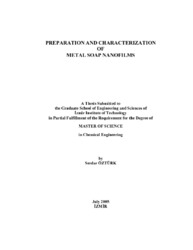Please use this identifier to cite or link to this item:
https://hdl.handle.net/11147/3240Full metadata record
| DC Field | Value | Language |
|---|---|---|
| dc.contributor.advisor | Balköse, Devrim | en |
| dc.contributor.author | Öztürk, Serdar | - |
| dc.date.accessioned | 2014-07-22T13:51:10Z | - |
| dc.date.available | 2014-07-22T13:51:10Z | - |
| dc.date.issued | 2005 | en |
| dc.identifier.uri | http://hdl.handle.net/11147/3240 | - |
| dc.description | Thesis (Master)--Izmir Institute of Technology, Chemical Engineering, Izmir, 2005 | en |
| dc.description | Includes bibliographical references (leaves: 127-132) | en |
| dc.description | Text in English; Abstract: Turkish and English | en |
| dc.description | xiv, 134 leaves | en |
| dc.description.abstract | In this study, the production of metal (zinc and calcium) stearate nanofilms by Langmuir-Blodgett (LB) film deposition process and their structural and electrical characterizations were investigated. The interaction of stearic acid monolayer with calcium, zinc cations as functions of pH, temperature, concentration of metal cation in the subphase and barrier speed was examined in detail. The effects of transfer surface pressure, the dipping speed, drying period, pH, concentration of metal cations in the subphase and temperature in the deposition of metal stearates onto glass substrates were optimized. Metal stearate LB films were prepared and characterized by X Ray Diffraction technique. It was revealed that the zinc stearate arrangement may be identified as under the orthorhombic (R) subcell with chain tilt angle of 31o, which was confirmed by IRspectrum of zinc stearate. Atomic Force Microscopy and Scanning Electron Microscopy images showed that surface roughness on glass substrates was decreased by firstly chrome coating and then silver coating. Zinc stearate coated surfaces have large crystal size around 90 nm in agreement with XRD calculation and contained grains and defects.The results of LB film deposition processes, structural characterization of LB films and the water vapour adsorption experiments presented that ZnSt2 LB films were easily formed and have good ordered structure in comparison to CaSt2 LB films. Therefore ZnSt2 LB films were chosen to study humidity sensor characteristics. Conductivity of ZnSt2 LB films was easily affected from environmentalconditions. No hysteresis during adsorption and desorption of water vapor on conductivity-voltage measurements was observed for zinc stearate LB film.As a result, zinc stearate LB films can be used as humidity sensor. By measuring conductivity in an humid atmosphere, humidity could be determined. | en |
| dc.language.iso | en | en_US |
| dc.publisher | Izmir Institute of Technology | en |
| dc.rights | info:eu-repo/semantics/openAccess | en_US |
| dc.subject.lcc | TP992 .O99 2005 | en |
| dc.subject.lcsh | Metallic soaps | en |
| dc.subject.lcsh | Electric conductivity | en |
| dc.subject.lcsh | Nanotechnology | en |
| dc.title | Preparation and characterization of metal soap nanofilms | en_US |
| dc.type | Master Thesis | en_US |
| dc.institutionauthor | Öztürk, Serdar | - |
| dc.department | Thesis (Master)--İzmir Institute of Technology, Chemical Engineering | en_US |
| dc.relation.publicationcategory | Tez | en_US |
| item.languageiso639-1 | en | - |
| item.fulltext | With Fulltext | - |
| item.openairecristype | http://purl.org/coar/resource_type/c_18cf | - |
| item.openairetype | Master Thesis | - |
| item.grantfulltext | open | - |
| item.cerifentitytype | Publications | - |
| Appears in Collections: | Master Degree / Yüksek Lisans Tezleri | |
Files in This Item:
| File | Description | Size | Format | |
|---|---|---|---|---|
| T000379.pdf | MasterThesis | 5.91 MB | Adobe PDF |  View/Open |
CORE Recommender
Page view(s)
542
checked on Jul 22, 2024
Download(s)
582
checked on Jul 22, 2024
Google ScholarTM
Check
Items in GCRIS Repository are protected by copyright, with all rights reserved, unless otherwise indicated.